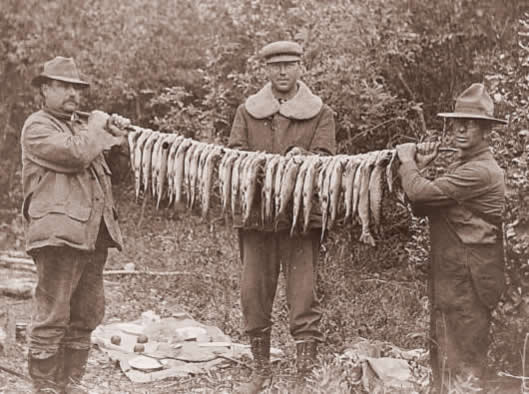
Soldiers from Fort Seward holding up a string of trout probably caught on Chilkat Lake, 1911-1913.
The seafood industry is historically and currently the most important industry in Haines, Alaska. In 1991, fishing represented 35% of the total employment in the Haines Borough. The Haines City Boat Harbor in the heart of town and Letnikof Boat Harbor, southwest of town, are both important moorings for the fishing boats of the Haines area. Lynn Canal is North America’s longest fjord. Surrounded by mountains over a mile high, the temperate rain forest and glacial rivers combine to form numerous streams. The Chilkoot and Chilkat watersheds are renowned for their productive wild salmon habitat. The Alaska Department of Fish and Game has the primary responsibility for managing the fishery in Lynn Canal.
Subsistence Fishing
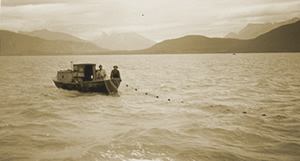
Subsistence fishing using a gill net.
Many Alaskans, native and non-native, depend upon subsistence fishing to put food on their tables throughout the year. All Alaskans are entitled to certain subsistence rights. Subsistence permits for Alaska residents must be obtained from the Alaska Department of Fish and Game each year. These permits allow residents to use gillnets to catch a specified number of sockeye, pink, and chum salmon each year in the Chilkat River and/or the Lynn Canal. Subsistence rules also exist for crab and shrimp fishing.
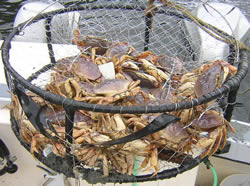
Dungeoness crab caught in a modern crab pot. Females and crabs that do not meet the minimum size requirements for harvest will be thrown back.
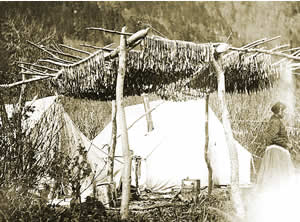
Eulachon (hooligan) drying on a Tlingit drying rack.
A spring ritual of particular importance to local Tlingits is the harvest of eulachon called “Saak” in Tlingit and commonly referred to as hooligan.
Eulachon are sea run smelt that return to fresh water to spawn for about one week each spring in early May. These fish are particularly prized for their oil by Tlingits who catch them with dipnets, store them in pits, and render the fermented fish in vats along the banks of the Chilkat River. The oil collected from this process is rich in nutritional value and a staple of the traditional Tlingit diet. Eulachon are also dried, smoked, and frozen. Eulachon return to both the Chilkat and Chilkoot Rivers in varying numbers each year. Their return signals the beginning of the food-gathering season. Eulachon can be gathered for personal use by any Alaskan with a fishing license.
Another fish that may be gathered for personal use is herring. When herring are abundant, their eggs are harvested by placing hemlock boughs, tied to the shore, on a spawning beach at low tide. The herring lay their eggs on the boughs.
Click for more information on Native Tlingit Fishing.
Sport Fishing
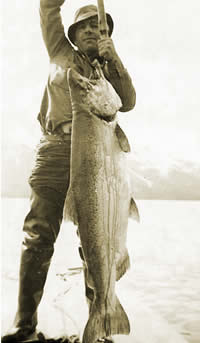
A Fort Seward soldier shows off a prized King Salmon, circa 1930s.
Chinook or king salmon arrive in the spring soon after the eulachon. A limited salt-water sport fishing season is allowed for these prized salmon depending on Alaska Fish and Game’s estimated number of fish returning each year. Sockeye and pink salmon arrive next, and both can be fished by sport fishermen in both fresh and salt water, although pink salmon are more likely to strike a lure than Sockeye. Coho or silver salmon arrive in late summer and fall. These fish are also prized by sport fishermen. Chum or dog salmon also arrive in late summer and run through December. Chums are sometimes caught and smoked but are not a favored sport fish. Dolly Varden and sea run char are good to eat and can be caught in both fresh and salt water during their extended season. Halibut, found in the deep waters of the Lynn Canal are another important sport fish, with a limit of two halibut per person. Lynn Cod…
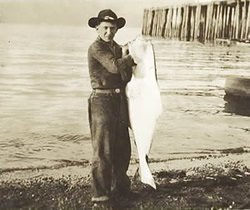
Fort Seward soldiers frequently fished during their “off-time.” Here’s one who caught a halibut: the perfect size for eating.
All five species of salmon run up the Chilkat River each year. The Chilkoot River supports four species of salmon only, as chinook do not run up the Chilkoot. Sport fishing regulations and licenses for both residents and non-residents can be obtained at any local sporting goods store in Haines which can also provide needed gear and useful sport fishing tips.
Commercial Fishing
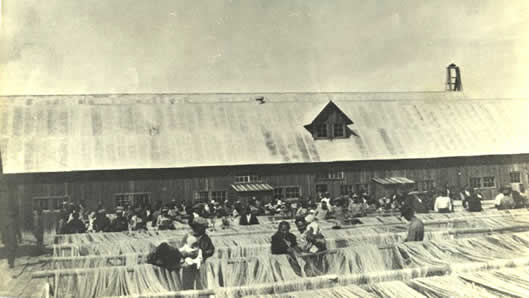
View of people working on spread-out nets at the cannery net dock at Haines Packing Company at Letnikof Cove, circa 1918.
Commercial fishing in the area began in the 1880s, and there were several canneries by the early 1900s. M.J. Kinney of Astoria built the first cannery, Chilkat Packing Company, on the eastern side of the Chilkat inlet in 1883. This cannery changed hands several times and finally burned in 1892.
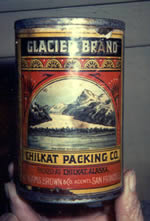
A can of salmon from the Chilkat Packing Company.
Another cannery on the eastern side of the inlet was operated from 1889 to 1893. It had a capacity of 800 cases per day. The Pyramid Harbor cannery on the western side of the Chilkat Inlet was built in 1883 by the Northwest Trading Company. This cannery burned in 1889, but was rebuilt at once and a pack was made that year. This cannery packed 1000 cases of fish per day and in 1896 employed over 100 people in the cannery (many of whom were Chinese) and over 200 fishermen both native and newcomers.
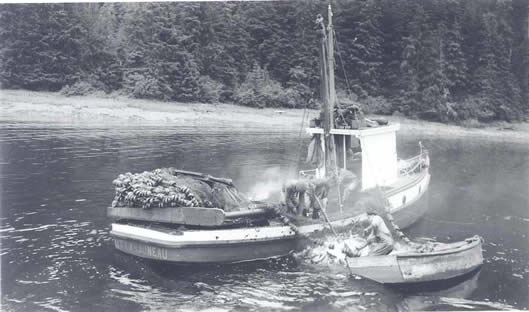
Gillnetters hauling in their catch, mid-1930s. Before modern technology, two boats were required to set a net and most were hauled in my hand.
Cannery fishermen used large gill nets and some purse seines. A fleet of steamers, transport ships, lighters, riverboats, and skiffs were also used in cannery operations. The average redfish (sockeye) catch from 1894 to 1898 was 300,000 per year. One sturgeon, weighing about 12 pounds, was taken in the Chilkat River Estuary in 1896. Coho and chum salmon were also commercially fished in these early times. Dolly Varden and halibut were also plentiful.
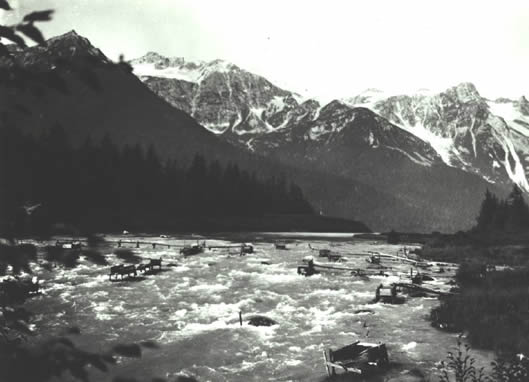
These fishing platforms built on the Chilkoot River were used by Tlingits to spear salmon during salmon runs.
The natives at this time typically fished from canoes moored to posts, or from platforms built over the streams. They used large gaffs, consisting of an unbarbed hook about 4 inches across the bend, secured to a stout pole, which was thrust into the water to impale a fish and drag it in. When fish were plentiful the hook was simply dragged through the water. A large number of fish from the Chilkoot River were taken this way. Gaffed fish were thrown into a wooden box alongside the fishermen. Wooden fish traps were also used, particularly in the Chilkoot. Narrow channels with rocks were also constructed in the Chilkoot to assist with the capturing of fish. Natives received from four to ten cents per redfish brought to the canneries. There was a cannery, operated by the Chilkoot Packing Company, on the northern shore of the Chilkoot inlet. Chilkoot redfish were quite large, averaging seven to eight pounds each. A handful of steelhead were also recorded at this cannery. The western shore of the Chilkoot River was the site of a significant native fishing village. Klukwan was (and is) the primary native village on the Chilkat.
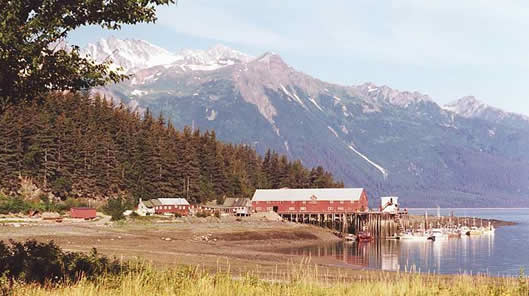
Letnikof Cannery, 1980s.
The Letnikof Cove Cannery, built by Tim Vogel in 1917 was purchased by Haines Packing Company in 1936. Other canneries in the area were located at Paradise Cove, in town, and near today’s ferry terminal. “Chilkoot Chips” (smoked salmon pieces) were produced from 1958-66 at Port Chilkoot in the former Fort Seward bakery building.
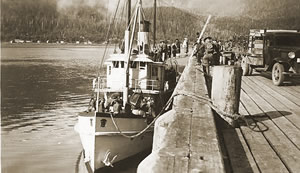
A fishing vessel docked at the Haines Boat Harbor.
The 1924 season saw a floating shrimp cannery from Petersburg at the end of the Haines City Dock. Shrimp were numerous and delicious, but the deep water made them difficult to catch. Twenty-five cents bought all the shrimp the six people could possibly eat at a beach picnic.
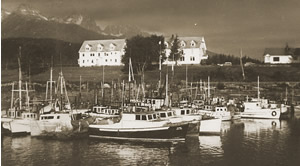
A view of the Haines Harbor and it’s fleet of fishing vessels. Haines House can be seen in the background.
Gillnetters Norm and Patricia Blank hand packed their freshly caught salmon from 1966-1995. They now vacuum pack their smoked salmon. Dijon Delights, located in the Ft. Seward area, has been the main source of a variety of fresh canned and smoked seafood since 1983. The Chilkat Center for the Arts, located behind Alaska Indian Arts in the Ft. Seward area, is a restored building that was originally part of the Pyramid Harbor Cannery. The building was cut into sections, hauled by barge around the peninsula, and then reassembled at its present site in 1919. At present, there are no commercial canneries operating in the Haines area, although a mock non-operational cannery opened on Main Street to cater to tourists for several years before closing in 2007. Haines Packing Company operates at the old Letinikof Cove cannery. Although they don’t can salmon, they do processes salmon for smoking and freezing and you can also purchase jarred salmon caviar.
Commercial fishing has declined statewide today. Although catches remain high through 2004, when measured against historical levels the value of the salmon harvest has plummeted. In 1990, the Alaska wild salmon harvest yielded 302,600 metric tons (statewide), with fisherman receiving $559 million for their catch. By 2002, the volume of harvest was lower at 238,000 metric tons, but the value had fallen to $130 million. The 21 percent decline in volume did not approach the much larger decline in value. The value of investments in vessels and gear have similarly collapsed. In 1990, CFEC estimated the market value of the 12,084 valid salmon limited entry permits at $1.247 billion. In 2002, estimates place the value of the remaining 11,421 permits at $204 million.
What Happened?
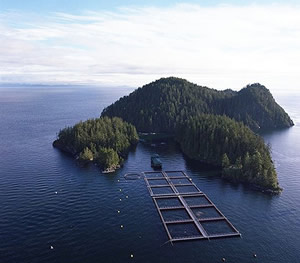
Salmon farming pens on the coast of British Columbia, Canada. Photo courtesy of the BC Salmon Farmers Association.
In the 1970s and 1980s, Alaska enjoyed a dominant position in the world salmon market. Siberian runs, the only real rival in terms of wild stock harvests, were safely behind the iron curtain, and not available on free world markets. Japanese high seas interception of Alaska salmon had been largely eliminated. Wild Atlantic harvests were miniscule, and techniques of pen rearing had not yet been perfected.
However, in the early 1990s farmed salmon (imported primarily from Canada and Chile) hit the market, creating a major new supply source. Unlike seasonal wild harvests, pen reared salmon are available fresh on a year round basis and most importantly, the supply is predictable. Wild salmon is by far the superior product (not only tasting better but being free of antibiotic, dyes and other harmful additives) but this makes little impression on the average consumer who only sees a price tag.
In the course of two decades, Alaska has fallen from world leadership in salmon production to a marginal position. The low prices paid for salmon, as well as several failed runs during critical years, have caused fishing incomes to drop and many fishermen (including those in the Haines area) left voluntarily or were forced out of the industry. It is clear that while the fishery is biologically sustainable, it is no longer economically viable for a large number of Alaska’s fishermen.
Kathleen Menke, 1997
Updated and revised by Blythe Carter, 2007, 2013
Bibliography:
Chilkat Valley News articles Oct 27,1988, Aug 23,1990, and Oct 13, 1994.
Enticknap, Peter M., “Lynn Canal Fishery Values,” December 14, 1992.
Gilbertsen, Neal, Labor Economists “The Global Salmon Industry” October 2003.
Hakkinen, Elisabeth, Historian, interview by Kathleen Menke, 1997.
Moser, J.F., “The Salmon and Salmon Fisheries of Alaska” Bulletin of the U.S. Fish Commission, 1898 and 1902.
Nanney, Dave and other Glacier Seafood partners, interviews by Kathleen Menke, July-September 1996.
Sheldon Museum Cannery Display, 1997.
Staska, Ray, Alaska Department of Fish and Game, interview by Kathleen Menke, February 12, 1996
